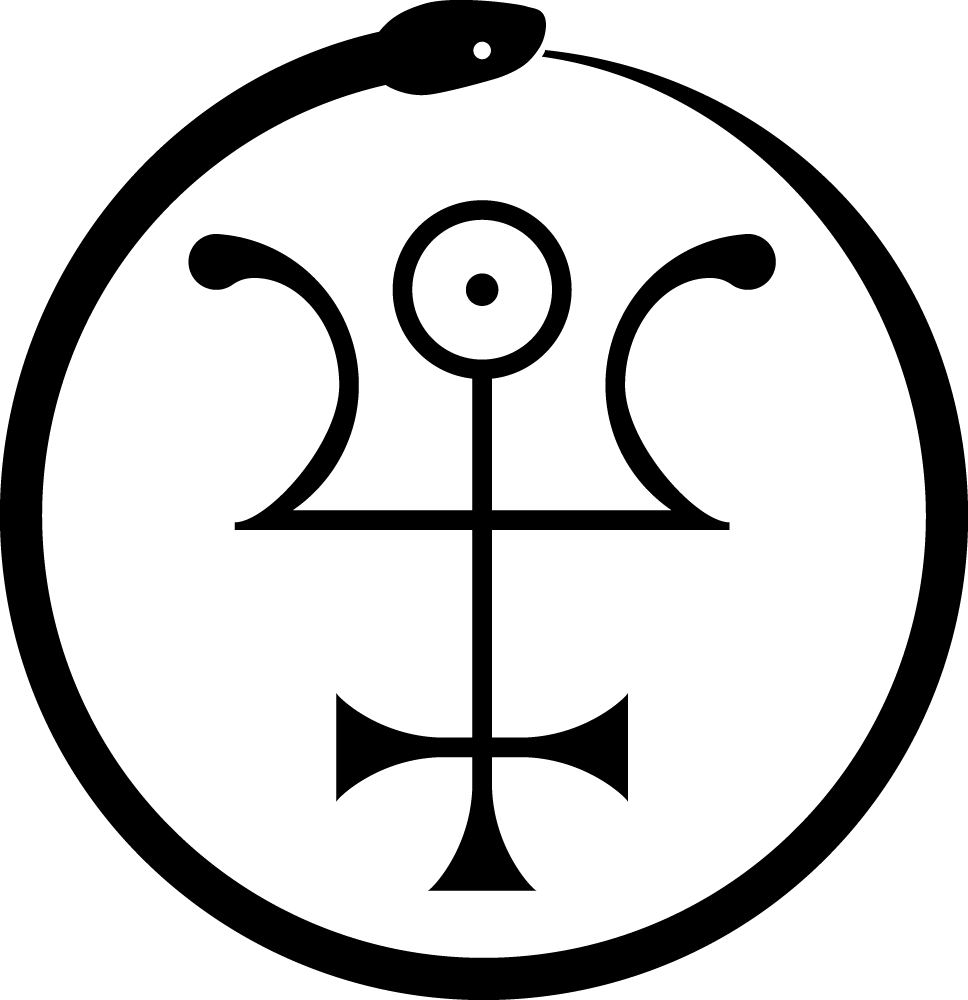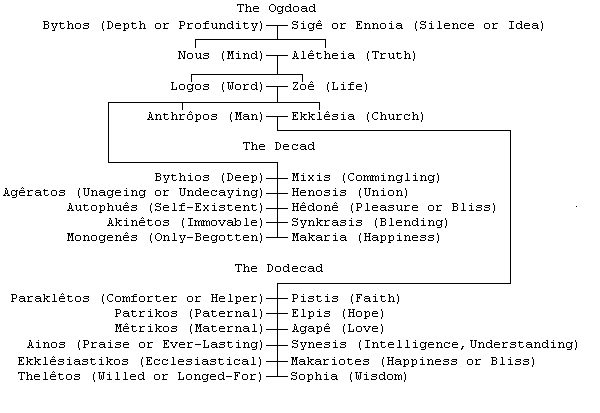(c. 105 – c. 165 e.v)
by T. Apiryon
Alexandrian founder (probably of Carthaginian birth) of the Valentinian sect of Gnostics during the reign of the Roman Emperor Antonius Pius. Valentinus may have studied with Basilides in Alexandria, he also claimed additional secret teachings from someone named Theodas, who was allegedly a disciple of Paul. In 136 e.v., he moved to Rome and was nearly elected Bishop of Rome. He was later excommunicated from the Roman Church.
Valentinus was the most prominent and influential of the historical Christian Gnostics. The Valentinian system refined and elaborated on the Basilidean and Simonian systems, developing a highly complex model of the universe in which each of fifteen successive levels of emanation (Aeons) occurs as a Syzygy, a male-female pair.
The Supreme Divinity, the Monad, the Father, is called Bythos (Depth or Profundity), who is encompassed by Sigê or Ennoia (Silence or Idea). Through Sigê, the first Syzygy of Aeons, Nous/Alêtheia, emanated from Bythos. These gave birth to the second Syzygy, Logos/Zoê, which brought forth Anthrôpos/Ekklêsia. These first eight Aeons were termed the Ogdoad. Logos/Zoê then brought forth another ten Aeons, termed the Decad, while Anthrôpos/Ekklêsia brought forth another twelve Aeons, termed the Dodecad. The entire scheme of the Aeons is shown below.
The totality of all thirty Aeons was termed the Plêrôma (fullness) and was considered to be in perfect balance. Of all the Aeons, only Nous was capable of comprehending Bythos, the Father, but was restrained by Sigê from revealing this mystery to the other Aeons. Sophia, the final Aeon, especially longed to comprehend the first cause of her being, and conceived a Plan (Enthymêsis) to do so, but was restrained by the Boundary (Horos) between Bythos and Sigê. She aborted her plan, and fell into a torment of confusion. From her tormented and confused passions arose the Demiurge, the God of Abraham and Moses (the later Gnostics named the Demiurge Saklas, “fool,” or Ialdabaôth, probably from the Hebrew El-Dibahoth, “God of Slanders”), who existed outside the Plêrôma. From her aborted Plan arose Achamôth (Wisdom, from the Hebrew Chokhmah– Achamôth typifies the “lower wisdom” in contrast to Sophia’s “higher wisdom”). The existence of Achamôth threatened to upset the balance of the Plêrôma. To prevent this, Bythos exiled her into the world of the Demiurge and set up a power called Stauros (Cross) to act as the boundary of the Plêrôma to protect it from Achamôth. To reestablish harmony within the Plêrôma, Nous and Bythos brought forth Christos (Christ) and To Pneuma Hagion (The Holy Spirit) to reveal the mysteries of the Father and to teach the Aeons their true nature. This being done, all the Aeons, as an act of gratitude, brought forth a new Aeon, Iesous Sôtêr (Jesus the Savior), along with a number of attendant angels.
Having been excluded from the Plêrôma and thrust into the darkness without benefit of form or intelligence, Achamôth became violently agitated. Christos projected himself through Stauros and provided her with form, but she was still without intelligence. Christos immediately withdrew back into the Plêrôma, and Achamôth attempted to follow him. She pressed herself against Stauros, which restrained her. In her agony, she uttered the mystic name IAO, and her Passions produced the material world (Hylê). From her Grief sprang Air, from her Fear came Water, from her Confusion came Earth, and from all three together arose Fire.
She then overcame her wild passions, and turned again to the Plêrôma. From her desire to return to the Father arose the Soul (Psychê) of All, including that of the Demiurge.
To aid her, Christos sent Iesous Sôtêr and his angels through Stauros into the World. He provided her with intelligence and separated her from her passions. Her ecstasy in clearly beholding Iesous and the angels produced the Sparks of Spirit (Pneuma), which would infuse the Spiritual Race.
Achamôth sought to give form to the matter that she had produced, and through the instrumentality of the Demiurge, she created the seven heavens (the Hebdomad) and Mankind; though the Demiurge ignorantly believed that he himself created these things. Through the unknowing Demiurge, Achamôth infused the Spiritual Sparks into the Pneumatic, or Spiritual, Race.
According to Valentinus, the Human Race is divided into three Races corresponding to the three sons of Adam: the Hylic, corresponding to Cain; the Psychic, corresponding to Abel; and the Pneumatic, corresponding to Seth. The idea of these three races is closely paralleled in other systems, notably in the Yogic conception of the Gunas– Tamas, Rajas and Sattva; the Tantric conception of the three types of aspirants, Pashu-bhâva, Vîra-bhâva and Divya-bhâva; in the Manichaean conceptions of the profane (matter, body), the Hearers (soul) and the Elect (Light, Spirit); in the three men who quested after the Holy Grail– Bors, Perceval and Galahad; in Bulwer-Lytton’s characters Glyndon, Zanoni and Mejnour; and in the Thelemic conception of the Man of Earth, the Lover and the Hermit.
The Pneumatic individual possesses the Sperma Pneumatikon, the Seed of Spirit, and the Knowledge of the Plêrôma. The Pneumatic is destined for salvation from the final destruction of the manifested Universe, regardless of his or her behavior. The Hylic dwells in the utter darkness of materialistic ignorance, and is destined for destruction. The Hylic is entirely composed of illusory, transitory matter, and will vanish along with all the other illusions at the restoration of the Plêrôma. The Psychic is situated half way between the Pneumatic and the Hylic, and possesses free will. Salvation for the Psychic is a matter of choice, of right aspiration, and of faith.
Iesous Sôtêr manifested on Earth by uniting at birth with the Messiah promised by the Demiurge. His task on Earth was to utter the Word of Truth, to impart the Gnosis to the Psychic Race that they may turn themselves toward the Plêrôma, the world beyond Space and Time, and away from the illusory and transitory material world.
In the end, when the task of Iesous Sôtêr has been accomplished, Achamôth will ascend to the Bridal Chamber and be wedded to Iesous. They will then both ascend into the Plêrôma, taking with them the Pneumatic Race, who will take their places among the angels of Iesous. The Demiurge will rise to the Middle Space formerly occupied by Achamôth, and will take with him those of the Psychic Race who have been saved. The manifested Universe, along with the Hylic Race, will then be engulfed by its own internal fire, and all matter will be utterly destroyed. Then the Plêrôma will be restored to its original perfection of peace, and all dualities will be resolved.
Valentinus had a number of prominent and influential successors who made further developments to the Valentinian system. These were Ptolemaeus, Heracleon, Theodotus, Marcus, Axionicus of Antioch, and Candidus of Athens. One of the characteristics of Gnosticism was the freedom of the Gnostic teacher to build upon, expand and modify the doctrines of his predecessors, and the students of Valentinus developed the Valentinian system in a number of different directions, some more philosophical, some more ritualistic; and many of their doctrines and ceremonies were “borrowed” by more “orthodox” religious teachers. Some modern scholars believe that the sacramental and liturgical system of the Roman Catholic Church was originally based in a large part on the Valentinian ritual systems developed by Marcus and Theodotus.
Valentinian churches were active until the late fourth century e.v. Several documents from the later Valentinian System have survived and are included in The Nag Hammadi Library. These are The Gospel of Truth, The Tripartite Tractate, The Gospel of Philip, and A Valentinian Exposition.
References:
Blunt, John Henry (Ed.); Dictionary of Sects, Heresies, Ecclesiastical Parties, and Schools of Religious Thought [Rivingtons, London 1874], Gale Research, Detroit 1974
Buonaiuti, Ernesto; “Symbols and Rites in the Religious Life of Certain Monastic Orders” [1934/35] in The Mystic Vision, Papers from the Eranos Yearbooks, Bollingen Series XXX.6, edited by Joseph Campbell, Princeton/Bollingen, Princeton NJ 1968
Fideler, David R.; “The Passion of Sophia, an Early Gnostic Creation Myth” in Gnosis, No. 1, The Lumen Foundation, Fall/Winter 1985
Hoeller, Stephan A.; “Valentinus, a Gnostic for All Seasons” in Gnosis, No. 1, The Lumen Foundation, Fall/Winter 1985
Jackson, Samuel McCauley (Ed. in Chief); The New Schaff-Herzog Encyclopedia of Religious Knowledge, Baker Book House, Grand Rapids, MI 1953
Laetscher, Lefferts A. (Ed. in Chief); The Twentieth Century Encyclopedia of Religious Knowledge, an Extension of the New Schaff-Herzog Encyclopedia of Religious Knowledge, Baker Book House, Grand Rapids, MI 1955
Malory, Sir Thomas; Le Morte d’Arthur, ed. by Janet Cowen, Penguin Books, London 1969/1986
Mead, G.R.S.; Fragments of a Faith Forgotten [1900], University Books, NY
Robinson, James M. (Ed.); The Nag Hammadi Library, Harper & Rowe, San Francisco, 1978
Rudolph, Kurt; Gnosis, Harper & Rowe, San Francisco, 1977
Original Publication Date: 5/9/95
Originally published in Red Flame No. 2 – Mystery of Mystery: A Primer of Thelemic Ecclesiastical Gnosticism by Tau Apiryon and Helena; Berkeley, CA 1995 e.v.

